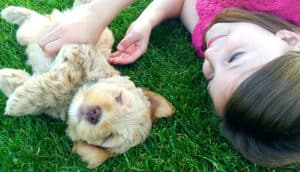Labradoodle puppies, like all puppies, have a tendency to be a little bitey. While it might be part of their exploration phase or a form of play, they may be doing it for other reasons.
This kind of habit, if not nipped in the bud early on, can become a very frustrating behavior for you, your family, and any household guests.
If you’re finding yourself in this situation, you’re probably wondering…
How do I stop my Labradoodle puppy from biting? Puppies usually get bitey when they’re trying to engage with you. The best way to control their biting is to divert their attention away from biting you, with a toy. This teaches them the boundaries of what they can and cannot bite. You can also try simply getting up and walking away when this negative behavior starts. Continuing to play with a biting puppy reinforces their unwanted actions and leads them to believe it’s acceptable behavior.
You can also try diverting their attention during episodes of biting with treats, harnessing this energy for a training opportunity.
Work on simple tasks like Sit, Down, and even a trick like a Turn. This helps teach them to respond to you rather than their puppy urges.
When still with their litter mates, puppies nip and bite as they play. So this behavior is rather ingrained in them.
So, patience and commitment are extremely important through this process.
Of course, you want what’s best for your Labradoodle, but it’s totally normal to be a bit unsure about how to handle certain behaviors.
For me, there was some trial and error in the beginning, but now that I’m the proud owner of two Doodles, I have a lot more experience under my belt.
I know what works and what doesn’t, what’s sound advice and what’s a bunch of baloney.
I’ve packed all that I’ve learned into our new guidebook, The Owner’s Guide To The Perfect Labradoodle, so you won’t have to play the guessing game when it comes to raising your pup correctly.
It covers everything from choosing and working with a breeder to training and socializing to dealing with all of that luxurious hair.
You won’t find a more comprehensive, honest look at what it takes to raise a perfect dog anywhere else. If you love your Doodle, this book is a must-have.
As an owner of 2 Labradoodles myself, I know how tough it can be to find good information. In the 60+ pages of this book, I share the information, resources, and breed-specific tips I wish I’d had from the start. You will save you time, money, and loads of frustration…take my word for it!
What Is A ‘Puppy Biting Phase’? How Long Will It Last?
All puppies bite. It’s a pure and simple fact. Their biting generally begins when they’re playing with their siblings, and it begins a way of playful fun for them.
They’re not doing it to be mean or aggressive, at least not when they’re little.
All puppies go through a biting phase, and thankfully, it doesn’t last forever.
It begins when their baby teeth start coming in at around two or three weeks of age. It generally continues until they lose their baby teeth and start getting their adult teeth.
Considering the fact that Labradoodle puppies don’t usually get their adult teeth until they’re about eight months old, you can expect several months of your puppy biting everything in sight, including your fingers and toes.
For a timeline of expected puppy tooth loss, head over to our Labradoodle Brushing Guide.
Why Do Puppies Nip And Bite?
Biting During Play
If you’ve ever watched a litter of puppies playing with each other, you’ll notice that they’re actually nipping and biting at each other.
It’s all in fun, and it can go on for hours until they get tired and go for a nap. They wake up and start chasing, wrestling, and biting each other all over again.
This usually starts when they’re a couple of weeks old, which coincides with the time their baby teeth are first coming in.
Unfortunately, this nipping and biting are not reserved just for their siblings and canine playmates. Puppies also nip and bite their owners when they’re near them or being held and petted.
Biting During Teething
The teething process goes for several months from the time the baby teeth come in until the final adult teeth are in.
Chewing and biting on things, even our fingers, brings them relief from the teething pain.
You’ll want to make sure you have a variety of teething toys for them to choose from. Some hard, some soft, and some even made from fabric.
This 12-pack bundle of toys did the trick when my first Labradoodle was gnawing on everything in sight.
It includes a bunch of different soft rope toys, chew toys, balls, and a soft flying disc – all just the right size for puppy mouths and perfect for satisfying irritated gums.
No products found.
No products found.
Giving them a good selection to choose from will help keep them from chewing on things like pillows and chair legs.
Another tip is to stuff a Puppy Kong (find them on Amazon) with peanut butter and toss it in the freezer for a few hours before giving it to your puppy.
The cold will help numb the gums, the rubber is durable and safe for chewing, and most pups absolutely adore them.
Puppies are much like human babies in that when they’re teething, they want to chew on anything in sight.
While teething may be a big reason why puppies nip and bite, it’s not the only one.
They do because it’s fun and a way for them to play. It also becomes a playful habit for them until it’s corrected.
Many people don’t realize this, but puppies who were taken away from their mothers too young are more likely to bite.
How To Prevent Nipping/Biting
It’s almost impossible to completely prevent nipping and biting because it’s something they start doing at a very young age and their siblings and their mother accept it.
While you may not be able to completely prevent it, it’s possible to decrease it and teach your puppy appropriate and inappropriate biting.
If you’ve ever watched two puppies playfully biting each other, you’ll notice that it will go on until one of them bites too hard and hurts the other pup.
The injured puppy will squeal, stop playing, and scurry away until it’s ready to play again.
The uninjured puppy associates the end of playtime with the pain and squealing from its sibling.
This interaction between the puppies teaches them how to control the intensity of their bites so the other doesn’t get hurt.
Knowing how to control the intensity or strength of their bite is known as bite inhibition. You can teach your puppy bite inhibition.
Techniques
There are a few different ways to stop your puppy from nipping and biting.
One way is to remove your fingers, or whatever he happens to be biting, and say a firm “no” and momentarily stop whatever you were doing with the puppy.
Start all over again and if the puppy repeats the biting, say “no” again. Keep on doing this until the puppy stops biting.
As soon as the pup stops biting and nipping, praise him and give him a treat.
Another way to stop the biting is to put the puppy down and walk away. Puppies love attention and they love playing.
If playtime ends as soon as they begin biting, they will eventually get the point.
One thing worth considering is that puppies always seem to be hungry. When they’re hungry, they nibble and bite even if they’re not actually eating.
They might just like the taste of your fingers and toes. If repeated nipping and biting is a big problem, try to avoid playing with the pup when you know he’s hungry.
A puppy that’s tired and has a full stomach is much less likely to be nibbling and biting.
When a young puppy is nipping because he’s teething, it’s not really something he can stop or control.
You may be able to curb the habit a little, but you won’t stop it altogether until the puppy is done teething. It’s important that you have patience with the puppy while still being firm.
Excessive Biting: When To Be Concerned
Although it’s been stated repeatedly that nipping and biting is perfectly normal behavior, it can become a problem when it becomes excessive.
Puppy biting can be considered excessive if the puppy doesn’t stop when it’s being firmly told to stop or if the puppy seems to forget the discipline very quickly.
It can become excessive if it seems like all the puppy wants to do is bite and nip. This behavior must be corrected before the puppy becomes a big dog.
Puppies are just so cute and adorable when they’re little. Even the sound of their little growls has an appeal that makes us laugh.
Unfortunately, by allowing it or participating in it, we’re encouraging the puppy and letting him believe it’s acceptable.
Puppy biting may also be excessive and cause for concern if it’s associated with this type of behavior:
- A fixed stare without losing eye contact.
- Prolonged and fierce growling.
- Posture becomes stiff.
- Aggression that comes for a specific situation.
Training Techniques To Stop Puppy Biting
You can use a few different training techniques to stop your Labradoodle puppy from biting.
You can choose the one that you’re most comfortable using as well as the one that seems to work the best on your puppy.
- Verbal cues – When the puppy starts biting you, state “NO!” in a firm voice and end the playtime. Let him know that playtime or attention time is over when he bites.
- Distracting/diverting the bad behavior – If your puppy is a consistent biter, you should always have a distraction in your pocket if you’re near the puppy. As soon as he starts biting, give him the toy or chew. While it may sound like you’re rewarding the biting, it’s actually more of a distraction from the biting.
- Time out – When your puppy begins biting and won’t respond to your discipline, put him in his crate or give him alone time. It’s important that this is not seen as a punishment or truly negative experience, so be careful here. Gently and calmly place your puppy in their crate.
- Discourage roughhousing with the puppy – We don’t realize that we are often responsible for a puppy’s biting and aggressive behavior. They’re just so cute that we roughhouse with them until it starts to get out of control. Discourage friends and family from roughhousing with the puppy in ways that will encourage him to bite.
Puppy biting is just one of the many issues we address in our Labradoodle Guidebook.
Because these are such wonderful dogs, we believe that owners should have the correct information and advice in one place from the very beginning to avoid making common mistakes that could negatively affect their relationship with their dog.
After all, you only get to raise your dog once. Shouldn’t it be an enjoyable, memorable experience that results in a well-adjusted, loving, and happy dog?
Related Questions:
What about play biting? Is that OK?
Play biting is still biting, and it could hurt a young child.
What might seem cute from an eight-week-old puppy will not be so cute when it’s a full-grown dog doing the biting because he was never taught not to bite.
Keep in mind the size of an adult dog’s mouth and teeth compared to a puppy’s mouth.
Why does my puppy try to bite my hand when I pet his head?
Your puppy may be biting your hand because he’s teething or simply because he enjoys you petting his head, and it’s his way of showing affection and trying to play with you.
This is what young puppies do. You might want to distract him by feeding him treats from your other hand.
In Summary…
Labradoodle puppies are adorable little creatures even when they’re acting all tough and trying to bite.
However, correcting that “tough guy” act is the first step towards raising a gentle, loving adult Labradoodle that can be a trusted member of the family.
The tips and technique we’ve shared with you should really help curb your puppies biting.
Just remember, it’s a process and will take time, patience, and consistency from everyone in the house.
Still have questions or concerns about your Labradoodle puppy?
Check out all of our Labradoodle articles to find solutions to common problems and tons of other information about this delightful breed.
Last update on 2024-04-23 at 00:17 / Affiliate links / Images from Amazon Product Advertising API






